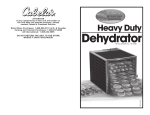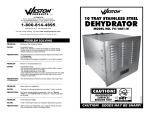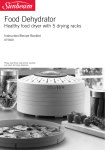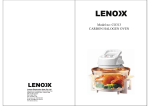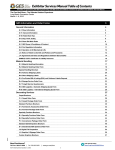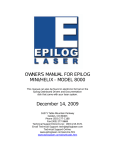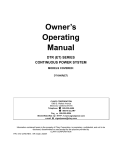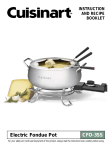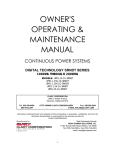Download Cabela's 28-0301 User's Manual
Transcript
ATTENTION If any components of this unit are broken or the unit does not operate properly, please contact Cabela’s Customer Service. Retail Store Purchases: 1-800-905-2731 (U.S. & Canada) Catalog and Internet Purchases: 1-800-237-8888 All International: 1-308-234-5555 DO NOT RETURN THE UNIT TO THE STORE WHERE IT WAS PURCHASED! SAVE THESE INSTRUCTIONS! REFER TO THEM OFTEN AND USE THEM TO INSTRUCT OTHERS. INSTRUCTION MANUAL 160 LITER DEHYDRATOR MODEL NO. 28-0501 80 LITER DEHYDRATOR MODEL NO. 28-0301 REV 041609 IMPORTANT! This appliance is a Dehydrator, not an oven. Its purpose is to dry, not cook. Dehydrator operation is not the same as that of an oven. . BEFORE dehydrating, heat meat to an internal temperature of 160 F (71 C) o o and poultry to 165 F (74 C) in an oven to kill any bacteria that may be present. o o .Heat the meat or poultry in an OVEN, not the Dehydrator. . Ideally, Set Temperature is only the highest temperature reached during a heating cycle. Set Temperature is not maintained. . Depending on a variety of factors including ambient conditions, state of food being dried and power supply, the Set Temperature may not be reached. . For maximum performance: do not use extension cords; operate the Dehydrator in area where the temperature is above 70oF (21oC); remove other appliances from the electrical circuit to which you connect the Dehydrator; make sure the door is fully closed with no gaps in the seal; connect the Dehydrator to an electrical circuit protected by a 20-Amp circuit breaker. . DO NOT use the Dehydrator outdoors. . Read and fully understand all instructions and warning prior to using the Dehydrator. APPLE & CREAM FRUIT LEATHER COMPONENT LIST DIAGRAM NUMBER PART DESCRIPTION 80-LITER 28-0301 160-LITER 28-0501 1 Door 28-0404 28-0504 2 Foot (4) 28-0403 N/A 3 Short Foot Bolt (2) 28-0327 N/A 4 Long Foot Bolt (2) 28-0328 N/A 5 Front Right Foot Bracket 28-0325 28-0325 N/A Swivel Caster (2) N/A 28-0503 Caster Nut (2) attached N/A Swivel Caster with Break (2) N/A 28-0502 Caster Nut (2) attached 6 Handle 28-0440 28-0540 7 Back Panel 28-0305 28-0505 8 Top Panel 28-0506 28-0506 N/A Bottom Panel 28-0307 28-0307 10 Fan 28-0108 28-0108 11 Heating Element 28-0310-N 28-0310-N 12 Diffuser 28-0311 28-0331 N/A Back Panel Diffuser N/A 28-0330 14 Non-Stick Rack -Set of 12 28-0313 28-0313 (2 Sets) 15 Main Computer Board 28-0515 28-0515 16 Shelves -Set of 12 28-0318 28-0318 (2 Sets) 17 Drip Tray 28-0519 28-0519 18 Temperature Sensor 28-0321 28-0321 19 Snack Stick hanger 28-0322 28-0322 20 Top Door Hinge 28-0333 28-0333 21 Bottom Door Hinge 28-0334 28-0334 N/A Front Foot Bracket 28-0332 28-0332 23 Rear Bottom Corner Bracket (2) 28-0336 28-0336 24 Circuit Breaker 28-0379 28-0379 25 Power Cord N/A N/A N/A LED Light Fixture 28-0507 (2) 28-0507 (3) 26 Control Panel 28-0514 28-0514 27 Back Panel 28-0305 28-0505 Before beginning the assembly, check the package contents for all of the parts. If you are missing any parts, or if any parts are damaged, contact Cabela’s Customer Service- Retail Store Purchases 1-800-905-2731 (U.S. & Canada) / Catalog & Internet Purchases: 1-800-237-8888 / All International: 1-308-234-5555 -2- 6 Apples 1 cup Plain Non-Fat Yogart . . . . 1/2 tsp Cinnamon 2-1/2 tsp Nutmeg 1/4 tsp Cloves Puree the ingredients in a food processor or blender until smooth. Place the fruit leather mats on the dehydrator racks. Spread the puree over the fruit leather mats until it is about 1/4” thick. Place the filled dehydrator racks in the dehydrator and dry until leathery and pliable but not sticky. SUPER ENERGY BARS 1 cup Barley, soaked for 3 days 2 cups soft Wheat (sprouted 1 day) 3/4 cup Dates 3 Tbsp Raw Honey 1 tsp Cinnamon 1 tsp Vanilla 1 cup Walnuts, soaked & chopped 1/2 cup Almonds, soaked & chopped . . . . . Process the barley, wheat and dates in a juicer using the solid plate. Add the honey, cinnamon, vanilla, walnuts and almonds. Mix well. Form the mixture into 1/4” bars and place onto a teflex sheet on the dehydrator racks. Place the filled racks into the dehydrator for 6-8 hours, depending on the desired moisture and size of the bars. Halfway thru the dehydrating process, remove the teflex sheet and turn the bars over. NOTSO SUN-DRIED TOMATOES 7 lbs. of firm, ripe Roma Tomatoes, cleaned & stems cut out 1 tsp. dried Basil 1 tsp. dried Oregano 1 tsp. dried Thyme 2 tsp. Salt . . . . . . . Cut the tomatoes into quarters. Scrape out all of the seeds without removing the pulp from the tomato. Sprinkle the seasonings over the tomatoes. Place the tomatoes, cut side up, directly onto the dehydrator racks. Set the dehydrator temperature to about 140°F. Place the filled racks into the dehydrator for 6-9 hours. A few hours thru the dehydrating process, gently turn the tomatoes over and press flat with your hand or a spatula. Repeat this step again in a few hours until dried. CHEESY CORN CHIPS 1 cup whole kernel or creamed corn 1 tablespoon chopped onion 1 cup freshly grated sharp cheddar cheese (the ready grated cheese is not as satisfactory for this) 1/2 cup diced red or green bell peppers 1/8 teaspoon cayenne pepper 1/8 teaspoon chili powder Salt to taste . . . . . Using a blender or food processor, mix all ingredients together at high speed. Spread mixture thinly onto Fruit Roll Sheets (Sold Separately). Dry at 130°F for approximately 10 hours or until dry on one side. Lift entire corn ring off of the Fruit Roll sheet, turn over and dry for two hours longer or until crisp. Break into pieces. -19- RECIPES HAWAIIAN JERKY MARINADE WARNING! Before cleaning, assembling or disassembling the Dehydrator, make sure the PLUG IS REMOVED FROM THE OUTLET/POWER SOURCE! ALWAYS unplug the Dehydrator when not in use. 1 tsp Salt 1 tsp ground Ginger 1/4 cup Pineapple Juice 1 Tbsp Brown Sugar 1/4 tsp Pepper 1/8 tsp Cayenne Pepper 1 crushed Garlic Clove 1/4 cup Soy Sauce 1 lb. (0.45 kg) lean Meat, sliced into 1/4” (0.6 cm) thin strips 8 1 CAJUN JERKY MARINADE 1 cup Tomato Juice 1/2 tsp Garlic Powder 1/2 tsp ground Black Pepper 1-1/2 tsp dried Thyme 1-1/2 tsp dried Basil 1-1/2 tsp Onion Pepper 1 tsp White Pepper 2 tsp Cayenne Pepper (or more to taste) 1 lb. (0.45 kg) lean Meat, sliced into 1/4” (0.6 cm) thin strips 16 20 6(Located behind Door) HOT JERKY MARINADE 1/3 cup Teriyaki Sauce 2 tsp Brown Sugar 2 tsp ground Black Pepper 1 tsp ground Horseradish 1 tsp Salt 1/2 tsp Paprika 1/2 tsp Chili Powder 1 Tbsp Olive Oil 1 Tbsp minced Garlic 1/4 tsp Tabasco Sauce 2 Tbsp seeded & finely chopped Jalepeno Peppers 1 lb. (0.45 kg) lean Meat, sliced into 1/4” (0.6 cm) thin strips BURGUNDY JERKY MARINADE 26 2 cups Burgundy Wine 1/2 cup Soy Sauce 3 Cloves Garlic, chopped 3 Tbsp Molasses Syrup 1 Tbsp ground Black Pepper 1 lb. (0.45 kg) lean Meat, sliced into 1/4” (0.6 cm) thin strips TURKEY JERKY MARINADE 1/4 cup Soy Sauce 1 Tbsp fresh Lemon Juice 1/4 tsp powdered Garlic 1/4 tsp Pepper 1/8 tsp Ginger 1-1/2 lb. (0.7 kg) Turkey Breast, sliced into 1/4” (0.6 cm) thin strips VENISON JERKY MARINADE 1/3 cup Soy Sauce 1 Tbsp Brown Sugar 1 tsp Salt 1/2 tsp Minced Garlic 1/2 tsp ground Black Pepper 1 lb. (0.45 kg) Venison, sliced into 1/4” (0.6 cm) thin strips 21 17 12 14 23 4 5 19 2 15 3 MARINADING INSTRUCTIONS . In a small glass bowl, combine all of the ingredients except the meat/poultry. Mix thoroughly. . Place a layer of meat/poultry into a glass baking dish, spoon sauce mixture over each layer. . Repeat until meat/poultry is 3-4 layers deep in the pan. . Cover tightly and marinate for 6-12 hours in the refrigerator or overnight. Stir occasionally to keep the meat/poultry coated in marinade. The longer the meat/poultry stays in the marinade, the more flavor will be absorbed into it. . Remove the meat/poultry from the marinade, removing excess marinade. . Lay the meat/poultry evenly onto the dehydrator trays, leaving 1/4” (0.6 cm) space between each strip of meat/poultry. . Follow the “Making Jerky “ instructions and the “Food Safety” instructions. -18- 18 BACK VIEW 24 25 27 10 11 -3- IMPORTANT SAFETY RULES WARNING! READ AND FULLY UNDERSTAND ALL INSTRUCTIONS AND WARNINGS PRIOR TO USING THIS UNIT. YOUR SAFETY IS MOST IMPORTANT! FAILURE TO COMPLY WITH PROCEDURES AND SAFEGUARDS MAY RESULT IN SERIOUS INJURY OR PROPERTY DAMAGE. REMEMBER: YOUR PERSONAL SAFETY IS YOUR RESPONSIBILITY! 1. ALWAYS DISCONNECT the Dehydrator from the power source before servicing, changing accessories or cleaning the unit. vents on the rear of the unit. Keep all objects and walls at least 6” (15 cm) from all sides of the Dehydrator. 2. ALWAYS USE A SEPARATE DEDICATED ELECTRICAL CIRCUIT to supply power to this Dehydrator. The circuit should not be less than #12 wire and MUST be protected with a 20 amp circuit breaker. If you are unsure of your electrical system, contact a qualified electrician. Failure to verify your electrical system may result in fire, injury or property damage! The unit will not heat to the Set Temperature unless this step is done. 12. DO NOT run the Dehydrator on any flammable surfaces such as carpeting or wood floors! BE SAFE and use the Dehydrator on a cinder block or concrete floor. 13. TO PROTECT AGAINST RISK OF ELECTRICAL SHOCK: DO NOT SUBMERGE THE DEHYDRATOR INTO WATER OR LIQUID. BE SURE THE DEHYDRATOR IS DISCONNECTED FROM THE POWER SOURCE BEFORE CLEANING. Wash all parts by hand and thoroughly dry. Thoroughly clean all parts that will come in contact with food before using the appliance. NEVER rinse appliance Dehydrator with a hose or pouring water, only use a moist cloth to clean the Dehydrator. DO NOT use the Dehydrator with wet hands or bare feet. DO NOT use near water. 3. NEVER LEAVE THE DEHYDRATOR UNATTENDED. Be safe, DISCONNECT the Dehydrator from power source before leaving the work area. Close supervision is necessary when any appliance is used near children. This appliance is NOT to be used by children. 4. Reduce risk of unintentional starting. Make sure the Power Switch is in the “OFF” position before attaching to the power source. 14. DO NOT allow water to drip inside of the Diffuser, damage to the Heating Element may occur. DO NOT remove the Diffuser from the Cabinet. Assembly integrity will be compromised and may void warranty. Follow the Diffuser cleaning instructions after EACH use. 5. DO NOT USE the Dehydrator if the Power Cord, Plug or any other parts are damaged. If the Power Cord or the Dehydrator is damaged, call Customer Service. DO NOT ATTEMPT TO REPLACE THE CORD. Be sure to not allow the Power Cord to drape into your work area. Check that all parts are operating properly, and perform the intended functions. Check for alignment of moving parts or any other conditions that may affect the operation. 6. NEVER use any accessories or parts from other manufacturers. Doing so will VOID YOUR WARRANTY and may cause fire, electrical shock or injury. SUMMARY Just remember the basics: • The leaner the meat, the better the jerky 20. DO NOT use the Dehydrator while under the influence of drugs, medications or alcohol. 10. DO NOT use outdoors. NOTE: Special considerations must be made when using venison or other wild game, since it can become heavily contaminated during field dressing. Venison is often held at temperatures that could potentially allow bacteria to grow, such as when it is being transported. Refer to the USDA Meat and Poultry Department for further questions or information on meat and food safety. 16. Failure to follow cleaning and maintenance instructions will decrease the life span of your Dehydrator and may cause serious product malfunction, injury or property damage. 19. DO NOT attempt to operate the Dehydrator if the Dehydrator itself is cold. The Dehydrator temperature should be at least 45oF (7oC) before beginning. 9. Be sure the Dehydrator is on a stable work surface. Be sure all the Dehydrator Feet are stable. Lock the Casters (if applicable) prior to use. CHILL Chilling food is very important. The danger zone where bacteria multiply is between o o o o o o 40 F and 140 F (4 C and 6 C). Your refrigerator should be set to 40 F (4 C) or below; o o your freezer should be 0 F (-17 C) or below. Simple rule: serve hot foods hot, cold foods cold. Use chafing dishes or hot plates to keep food hot while serving. Use ice water baths to keep cold foods cold. Never let any food sit at room temperature for more than o o 2 hours - 1 hour if the ambient temperature is 90 F (32 C) or above. When packing for a picnic, make sure the foods are already chilled when they go into the insulated hamper. The hamper won’t chill food - it just keeps food cold when properly packed with ice. Hot cooked foods should be placed in shallow containers and immediately refrigerated so they cool rapidly. Make sure to cover foods after they are cool. Remember drying food is as much an art as any other form of cooking. Once familiar with the basics, experiment to create unique dried foods. 18. BEWARE! Some surfaces of the Dehydrator may become very HOT during use! Serious injury may result! DO NOT touch these parts during operation or until they cool after use. 8. Electrical repair must be done by your authorized dealer. Use only factory original parts and accessories. Modification of the Dehydrator voids the warranty. CLEAN Wash your hands and work surfaces frequently when you are cooking. Washing with soap and warm water for at least 15 seconds, then dry with a paper towel. 15. After cleaning, make sure Dehydrator is completely dry before reconnecting to the power source – if not; ELECTRICAL SHOCK may result, and may result in personal injury. 17. DO NOT operate the Dehydrator on a hot stove-top or inside an oven. DO NOT allow the power cord to drape over the Dehydrator or hot surfaces. 7. The Manufacturer declines any responsibility in the case of improper use of the Dehydrator. Improper use of the Dehydrator voids the warranty. Make sure to wash your hands after handling raw meats or raw eggs. Washing hands with soap and water, or using a pre-moistened antibacterial towelette is absolutely necessary after you have touched raw meat or raw eggs. Not washing hands and surfaces while cooking is a major cause of cross-contamination. • Do not overlap food products on the drying racks • Properly pre-treat fruits and vegetables • Drying times will vary • Blot excess moisture from surface of foods while drying • Rotate racks if drying is uneven • Always follow food safety guidelines for meats, poultry and fish to make sure the finished product is free of disease-causing bacteria 11. This Dehydrator contains intake and exhaust SAVE THESE INSTRUCTIONS! Refer to them often and use them to instruct others. -4- -17- DRYING FLOWERS • The flowers should be dry to start with, best if picked after the dew has dried and before the night damp sets in. Dry the flowers as soon as possible after picking. • The best condition for drying flowers is a dry, warm, dark, clean and well ventilated area, which makes a dehydrator an ideal setting. Flowers will retain the best color and condition when dried quickly. • A low temperature should be used to retain the natural oils. • Strip off the leaves or if you prefer to keep the foliage. Discard any brown or damaged leaves. GROUNDING INSTRUCTIONS This appliance must be grounded to protect the operator from electric shock during use. For this purpose, it is equipped with a three-conductor power cord and threeprong grounding-type plug (Figure A). The plug only fits three-hole electric receptacles. For the plug to fit a two-hole receptacle, you will need a Grounding Plug Adapter with a wire or metal tab (Figure B). Connect the wire/tab to the electrical outlet with the cover plate screw. The screw must be metal. The electrical box must be properly grounded (Figure C). 3-Hole Electrical Receptacle Figure A Grounding Type Plug Grounding Plug Adapter Figure B Metal Tab or Wire • Place on the dehydrator Rack in a single layer, avoiding overlapping. • Drying times will vary considerably depending on the size of the flower and the amount of foliage. Dry at 100°F (38°C). Figure C 3-Hole Electrical Receptacle FOOD SAFETY There are basic rules to follow when handling food. They are COOK, SEPARATE, CLEAN, and CHILL. COOK It’s crucial to cook food to a safe internal temperature to destroy bacteria that is present. The safety of hamburgers and other foods made with ground meat has been receiving a lot of attention lately, and with good reason. When meat is ground, the bacteria present on the surface is mixed throughout the ground mixture. If this ground meat is not cooked o o o o to at least 160 F to 165 F (71 C to 74 C), bacteria will not be destroyed and there’s a good chance you will get sick. Solid pieces of meat like steaks and chops don’t have dangerous bacteria like E. coli on the inside, so they can be served more rare. Still, any beef cut should be cooked to an o o internal temperature of at least 145 F (63 C) (medium rare). The safe temperature for o o o o poultry is 180 F (82 C) and solid cuts of pork should be cooked to 160 F (71 C). Eggs should be thoroughly cooked too. If you are making a meringue or other recipe that uses uncooked eggs, buy specially pasteurized eggs or use prepared meringue powder. SEPARATE Foods that will be eaten uncooked and foods that will be cooked before eating MUST ALWAYS be separated. Cross-contamination occurs when raw meats or eggs come in contact with foods that will be eaten uncooked. This is a major source of food poisoning. Always double-wrap raw meats and place them on the lowest shelf in the refrigerator so there is no way juices can drip onto fresh produce. Then use the raw meats within 1-2 days of purchase, or freeze for longer storage. Defrost frozen meats in the refrigerator, not on the counter. When grilling or cooking raw meats or fish, make sure to place the cooked meat on a clean platter. Don’t use the same platter you used to carry the food out to the grill. Wash the utensils used in grilling after the food is turned for the last time on the grill, as well as spatulas and spoons used for stir-frying or turning meat as it cooks. -16- 80-L DEHYDRATOR ASSEMBLY WARNING! Before cleaning, assembling or disassembling the Dehydrator, make sure the Dehydrator is OFF and the PLUG IS REMOVED FROM THE OUTLET/POWER SOURCE! 1. Make sure the Dehydrator is turned off and unplugged. 2. Remove the Racks and any other loose items from the interior and close the Door. 3. Gently lay the Dehydrator onto its left side (when facing the Door) on a rug, folded blanket or other similar article to prevent scratching. DO NOT lay the Dehydrator onto its right side because the glass Door may fall open and break! DO NOT lay the Dehydrator onto its front or back to avoid damaging the Door, Control Panel and/or Circuit Breaker. 4. Insert the Short Foot Bolts into the holes at the bottom of the Feet until the Bolts threads protrude out. Thread the Bolts & Feet into the Front Foot Brackets. 5. Tighten the Short Foot Bolts with a screwdriver. 6. Insert the Long Foot Bolts into the holes at the bottom of the Feet until the Bolts threads protrude out. Thread the Bolts & Feet into the Rear Bottom Corner Brackets. 7. Tighten the Long Foot Bolts with a screwdriver. 8. While holding the Door closed, carefully stand the Dehydrator upright onto the Feet. -5- 160-L DEHYDRATOR ASSEMBLY WARNING! Before cleaning, assembling or disassembling the Dehydrator, make sure the Dehydrator is OFF and the PLUG IS REMOVED FROM THE OUTLET/POWER SOURCE! 1. Make sure the Dehydrator is turned off and unplugged. 2. Remove the Racks and any other loose items from the interior and close the Door. 3. Gently lay the Dehydrator onto its left side (when facing the Door) on a rug, folded blanket or other similar article to prevent scratching. DO NOT lay the Dehydrator onto its right side because the glass Door may fall open and break! DO NOT lay the Dehydrator onto its front or back to avoid damaging the Door, Control Panel and/or Circuit Breaker. 4. Screw a Caster Nut (attached to Caster for shipping) onto the threaded stem of each Caster until it stops. 5. Screw the Swivel Casters into the Rear Bottom Corner Brackets until they stop. HINT: Hold the Caster frame with one hand and rotate the swivel with your other hand. 6. Screw the Swivel Casters with Breaks into the Front Foot Brackets until they stop. 7. Tighten each Caster Nut with a 12-mm (1/2”) open-end wrench. Turn the Caster Nuts clockwise. You want to tighten them to the Dehydrator, not the Casters. DO NOT over-tighten. 8. Visually inspect the gap between the Door and Front Left Foot Bracket to make sure the stem of the Caster does not contact the bottom of the Door. If there is contact, loosen the Caster Nut and move the Caster down. Screw the Caster Nut onto the stem of the Caster. This time, however, do not screw it all the way down. Leave a small gap (this will shorten the length of stem that protrudes through the Foot Bracket). Reinstall the Caster as described above. Inspect and repeat if necessary. Increase the size of the gap each time. 9. While holding the Door closed, carefully stand the Dehydrator upright onto the Caters. PRE-OPERATING INSTRUCTIONS If you are using a marinade, shake off excess liquid from the meat before spacing it evenly in single layers, approximately 1/4”-1/2” (0.6-1.5 cm) apart, on the Dehydrator Racks. IMPORTANT NOTE: DO NOT place jerky over the center hole of the Racks. This will impede airflow to the center of the Cabinet and could result in uneven drying. Dry meat at 145-150°F (62.7-65.6°F) for 4-7 hours. You may need to blot fat droplets from the surface of the meat occasionally, using a paper towel. Drying times may vary based on many circumstances including but not limited to: the relative humidity of the room, the temperature of the meat at beginning of drying process, the amount of meat in the dehydrator, leanness of meat, etc. Always allow jerky to cool before taste testing. STORING JERKY Wrap jerky/snack sticks in aluminum foil and store in a thick plastic food storage bag, or place jerky/snack sticks in a jar with a tight lid. Avoid storage in plastic containers or bags without wrapping in aluminum foil or wax paper first. Jerky/snack sticks should be stored in a dark, dry, place between 50-60°F (10-15.6°C). You can store properly dried jerky/snack sticks at room temperature for 1 to 2 months. To extend the shelf life to up to 6 months, store jerky/snack sticks in the freezer. Be sure to label and date all packages. RECONSTITUTION • While it is not necessary to reconstitute dried foods, it can be done with ease. Vegetables can be used as a side dish or in recipes very effectively after being reconstituted in the following way. • Soak vegetables in cold, unsalted water for 3-7 minutes before cooking. If planning to soak the food any longer, it should be placed in the refrigerator while soaking. After soaking, it is best to cook the vegetables in the same water in which they soaked. Simply bring the water to a boil and cook the vegetables until tender. • Generally 1 cup of dried vegetables will result in about 2 cups after reconstitution. Fruits reconstitute at a ratio of approximately 1:1-1/2 cups. • Reconstitution time will vary depending on the thickness of the dried food and the temperature of the water used. Soaking the food in warmer water will speed up the process, however, it may result in loss of flavor. • DO NOT operate the Dehydrator without the Feet / Casters installed. • Locate the Dehydrator on a clean, level, dry, non-flammable, surface at least 6” (15 cm) away from any wall. Avoid carpeted surfaces. • Set the brakes on the two front-mounted Swivel Casters (160-L model) . -6- -15- BEEF: Choose Flank, Round or Sirloin Tip cuts, as they are the best beef cuts for making jerky. SET UP WILD GAME: Venison makes excellent jerky because it does not contain marbleized fat. Flank or Round Cuts work best. Bear and Elk meat also make very good jerky. POULTRY: Whether making chicken or turkey jerky, it is important that the meat be cooked heated to an internal temperature of 165oF (74oC) before dehydrating to kill disease-causing bacteria. FISH: Drying fish into jerky requires a lot of attention. It must be cleaned and deboned properly and rinsed thoroughly to ensure that all the blood is washed away. Steam or bake the fish at 200oF (93oC) until flaky before dehydrating. 1. Make sure the Power and Light Switches are both set to “OFF.” MAKING JERKY Meat should be as lean as possible. Using lean meat will help the meat dry faster and aid in cleanup by decreasing fat drippings. Ground meat should be 80% to 90% lean. Ground turkey, venison, buffalo and elk are other excellent choices for Jerky. Jerky seasonings are available for all tastes, or you can get creative and make your own. Whenever you make Jerky, you should cure the mixture with cure (sodium nitrite). The cure is used to help prevent botulism during drying at low temperatures. Follow the manufacturer’s directions on the cure packet. Keep raw meats and their juices away from other foods. Marinate meats in the refrigerator. Do not leave meats unrefrigerated. Prevent cross-contamination by storing dried jerky away from raw meat. ALWAYS wash hands thoroughly with soap and water before and after working with meat products. Use clean equipment and utensils. Keep meat and poultry refrigerated at 40°F (4.4°C) or slightly below; use or freeze ground beef and poultry within 2 days; whole red meats, within 3 to 5 days. Defrost frozen meat in the refrigerator, not on the kitchen counter. 2. Plug the Dehydrator into an electrical outlet. DO NOT use extension cords. 3. Set the Power Switch to “ON.” 4. Fill the Racks with food or other items to be dried. 5. Load the Racks in the Dehydrator. Push each Rack in until it stops. IMPORTANT: There are three notched Racks. Place these Racks (with the notch to the back) on the top three Rack Supports. The notches prevent the Racks from touching the Temperature Sensor on the back inside wall near the top. Any contact between these parts may cause false temperature readings and/or cycle irregularities. 6. Close the Door, firmly press on the Door to ensure a good seal. ...PROCEED TO “PROGRAMMING” Special considerations must be made when using venison or other wild game, since it can become heavily contaminated during field dressing. Venison is often held at temperatures that could potentially allow bacteria to grow, such as when it is being transported. Refer to the USDA website for further information on food safety. (www. usda.gov or www.fsis.usda.gov/fact_sheets/index.asp) When using a Dehydrator, check the temperature of the Dehydrator with a dial thermometer before drying jerky. The minimum recommended temperature for drying meats is 130°F (54°C). Temperatures below 130°F (54°C) are not recommended. IMPORTANT: Before placing the meat in a Dehydrator, it is highly recommended to heat the meat to 160°F (71°C) BEFORE the dehydrating process. This step assures that any bacteria present will be destroyed by wet heat. After heating to 160°F (71°C), maintaining a constant Dehydrator temperature of 130-140°F (5460°C) during the drying process is important because: 1.) the process must be fast enough to dry food before it spoils; and 2.) it must remove enough water so that microorganisms are unable to grow. -14- -7- PROGRAMMING LIGHT BULB REPLACEMENT WARNING! Before cleaning, assembling or disassembling the Dehydrator, make sure the Dehydrator is OFF and the PLUG IS REMOVED FROM THE OUTLET/POWER SOURCE! 1. Turn off the Dehydrator Lights. Turn off and disconnect the Dehydrator from the power outlet. 2. Let the Dehydrator cool. DO NOT attempt to replace a Light Bulb while the Dehydrator is hot. Digital Display 7. TO SET THE TIME: Press the “TIME” Button on the Control Panel one time. Use the “UP” & “DOWN” Buttons on the right side of the Control Panel to set the countdown timer hours (23 hour maximum). Press the “TIME” Button again to switch to minutes. Similarly set the minutes (5 minute increments). 8. TO SET THE TEMPERATURE: Press the “TEMP” Button one time. Use the “UP” & “DOWN” Buttons to set the temperature (160oF maximum, 50oF minimum, 5 degree increments). NOTE: Set Temperature is the maximum temperature the Dehydrator could reach during operation. 9. You do not need to push any other buttons. The Dehydrator will automatically start after a brief pause. NOTE: The Dehydrator will start while you’re programming if you delay. Don’t worry, this is normal. Just continue programming as instructed above. 3. Remove all of the Racks. LED Light Fixture 4. Remove the Back Panel of the Dehydrator. 5. Locate the LED Light Fixture that you wish to replace, and disconnect the wires from the Light Fixture from the white Wire Connector on the unit by squeezing together the two clips on the Wire Connector. Wire Connector Wire Connector Push Metal Clip LED Light Fixture 6. Press together the two sides of the Metal Clip on the Light Fixture to release it from the body of the Dehydrator and then gently push the Light Fixture into the Cabinet of the unit, being sure to have a grip on the wires connected to the Light Fixture so it does not drop into the Dehydrator Cabinet. Discard the removed Light Fixture. Push Metal Clip 7. Insert the replacement Light Fixture into the vacant hole where the old Light Fixture was by first feeding the wire connected to the Light Fixture first. 8. Line up the Light Fixture with the hole and push it back until the Metal Clips on the back of the Light Fixture lock into place. 9. Re-connect the Wire Connector attached to the Light Fixture with the Wire Connector the old Light Fixture was connected to by pressing them together until they lock. ...PROCEED TO “FUNCTION” FUNCTION 10.The Digital Display on the Control Panel will continuously cycle while the unit is operating. It will alternately display: the preset drying time “SET TIME;” the remaining drying time “TIME REMAINING;” the preset temperature “SET TEMP;” and the actual current temperature inside the Dehydrator “ACTUAL TEMP” (measured by the Temperature Sensor on the back wall near the top). NOTE: The “SET TEMP” is only the highest temperature reached during a heating cycle. The “SET TEMP” is NOT maintained. 11.The Dehydrator will emit 8 beeps at startup and when the interior temperature reaches the preset value. 12.The Dehydrator automatically stops (Fan & Heater) when the countdown timer reaches 0. Unit power will remain on, however. ...PROCEED TO “POST OPERATION” -8- 10. Line the Back Panel of the Dehydrator up and re-install the removed screws to mount the Back Panel. WHEN DRYING... SAUSAGE OR SNACK STICKS: Use the Snack Stick Hangers to hang and dry sausage links and snack sticks. After removing all the Racks from your Dehydrator, simply drape the links over the Snack Stick Hangers and slide Snack Stick Rack Supports them into the top Rack Hangers Rack Supports Supports. Be sure not to allow the links to rest on the bottom of the Cabinet or on top of the Diffuser. GROUND MEATS: Whenever making jerky from ground meats, you can use a jerky gun or such tool to create perfect strips of jerky as well as snack sticks. -13- CABINET DOOR Wipe the Door and Seal clean with a moderately damp cloth and soap if necessary. Wipe off any residue if soap is used. Wipe the glass clean with a rag or paper towels and glass cleaner. DRIP TRAY Empty then wash the Drip Tray in warm soapy water. Rinse and dry the Drip Tray before re-installing it in the Dehydrator. TROUBLESHOOTING WARNING! Before cleaning, assembling or disassembling the Dehydrator, make sure the Dehydrator is OFF and the PLUG IS REMOVED FROM THE OUTLET/POWER SOURCE! The Dehydrator loses power and will not restart. 13.Set the Power Switch to “OFF” when you are done. 14.Unplug the Dehydrator when not in use. 15.Clean the Dehydrator after each use, especially the Diffuser. “CLEANING INSTRUCTIONS” section of this booklet. GENERAL OPERATING INSTRUCTIONS • The purpose of this Dehydrator is to dry, not cook. It does not operate in the same manner as an oven. Its operation and performance should not be compared to that of an oven. • The maximum temperature to which you can set the Dehydrator is 160oF (71oC). The Dehydrator may or may not reach Set Temperature depending on several factors including: the temperature in the area where the Dehydrator is operating; whether or not an extension cord is being used; whether or not the Dehydrator is sharing the electrical circuit with other appliances; food thickness, temperature and moisture content; the amount and position of food on the racks. Circuit Breaker Reset Button Uneven or incomplete drying. • For maximum Dehydrator performance: DO NOT use extension cords; operate the Dehydrator in an area where the temperature is above 70oF (21oC); remove all other appliances from the electrical circuit to which you connect the Dehydrator; make sure the door is fully closed with no gaps in the seal; connect the Dehydrator to an electrical circuit protected by a 20-Amp circuit breaker. • Do not cover the center holes in the Racks. • Rotate the Racks every 45 to 90 minutes depending on the food being dried. Move the top Rack to the bottom. Move all other Racks up one shelf. Turn the Racks around. • Don’t crowd food items. Space items ½” to 1” (1.3 to 2.5 cm) apart on the Racks. • Increase the drying time and temperature. • Do not block the vents on the bottom of the Dehydrator. • Keep the Dehydrator at least 6” (15.2 cm) away from any wall. If the above tips do not resolve the problem you are having with the Dehydrator, contact Customer Service at the number on the back of this manual for additional information and further troubleshooting. -12- See the • The Dehydrator’s “SET TEMP.” is only the highest temperature that will be reached during a heating cycle. It is the temperature at which the Heater turns off. The Fan will continue to operate. Heating resumes when the temperature falls 5 to 10 degrees below the “SET TEMP.” • Turn the Dehydrator off and disconnect the Power Cord from the electrical outlet. Press the button on the Circuit Breaker (located on the back of the Dehydrator near the top) to reset it. • Check the household circuit breaker controlling the electrical outlet to which you connected the Dehydrator. Make sure that the breaker is rated 20 Amp and no other appliances are used at the same time. Reset it, if necessary. POST OPERATION -9- DEHYDRATING TIPS As with most methods of cooking, good preparation is essential to success. Following a few basic guidelines will greatly increase the quality of the dehydrated product and decrease the time needed to make it. CLEANING INSTRUCTIONS WARNING! Before cleaning, assembling or disassembling the Dehydrator, make sure the Dehydrator is OFF and the PLUG IS REMOVED FROM THE OUTLET/POWER SOURCE! NOTE: Before dehydrating, heat meat to an internal temperature of 160oF (71oC) and poultry to 165oF (74oC) to kill any bacteria that may be present. Heat the meat or poultry in an oven, not the Dehydrator. • IMPORTANT! Clean the Dehydrator after EACH use. Do not use abrasive cleansers. The Racks are NOT dishwasher safe. • To prevent fruit from darkening, briefly soak slices in lemon or pineapple juice before drying. You also can soak fruit slices in ascorbic acid, which is sold in most pharmacies and health food stores in powder or tablet form. Prepare a solution of ascorbic acid according to the manufacturer’s instructions. Soak fruit slices in the solution for 2 to 3 minutes before dehydrating. • DO NOT allow grease to build up inside the Dehydrator, especially on the Diffuser. Component damage or fire may result. • Water or steam blanch* vegetables before drying to stop enzymatic action. To water blanch, place vegetables directly into boiling water and cover. Remove after three minutes. To steam blanch, place vegetables in a steamer basket and steam for 3 to 5 minutes. • Maintain a uniform thickness when slicing food items for dehydration. This will ensure the items dry at the same rate. • Maximum slice thickness for fruits and vegetables should be 1/4” (0.7 cm) unless otherwise specified by a recipe. • Maximum slice thickness for meats should be 3/16” (0.5 cm) unless otherwise specified by a recipe. • Lean meat makes better product than fatty meat. • Marinate meat before heating and dehydrating. • Food shrinks by half or more during dehydration. A pound of meat, for example, will yield 1/2 to 1/3 lb (0.15 to 0.2 kg) of jerky. Don’t cut pieces too small. • Store dried foods in a closed container in a cool, dark, dry location. The best storage temperature is between 50oF and 60oF (10o and 16oC). Dried food should retain its freshness for months when stored this way. • The actual time needed to dry a food depends on many factors including the food’s moisture content, fat content, thickness and temperature as well as ambient humidity and temperature. • Water droplets may form on the surface of meat and other items while drying. Occasionally blot the food items to remove the droplets. *Blanching is not required for all vegetables. Check the recipe or a drying guide. -10- • WARNING! DO NOT immerse the Dehydrator in water. DO NOT spray the Dehydrator with water. DO NOT let water drip into the Diffuser. • Turn off and unplug the Dehydrator. Allow the Dehydrator to cool. Clean the Racks, interior and exterior Cabinet, Diffuser, Door and Drip Tray as described below. NON-STICK RACKS Wash the Racks by hand with a soft brush in warm soapy water. Rinse and towel dry. Make sure the Racks are completely dry before returning them to the Dehydrator. CABINET INTERIOR Wipe the Cabinet Interior and clean Rack Supports with a moderately damp cloth and soap if necessary. DO NOT use abrasive cleansers. Wipe off any residue if soap is used. CAUTION: DO NOT let water drip into the Diffuser. Electric shock or unit damage may result. If necessary, cover the Diffuser with a dry towel while cleaning the Cabinet Interior and Rack Supports. CABINET EXTERIOR Wipe the Cabinet Exterior with a moderately damp cloth and soap if necessary. Wipe off any residue if soap is used. DIFFUSER Wipe the top and sides of the Diffuser with a slightly damp cloth and soap if necessary. DO NOT use abrasive cleansers. Remove any residue if soap is used. CAUTION: DO NOT let water drip into the Diffuser. Electric shock or unit damage may result. Inspect the vent holes on the sides and top of the Diffuser. All the holes must be clean and fully open. Use a toothpick or other pointed object to remove any residue. Be careful not to push residue into the Diffuser. -11- Diffuser Top Vent Holes Be sure the Holes are Open










